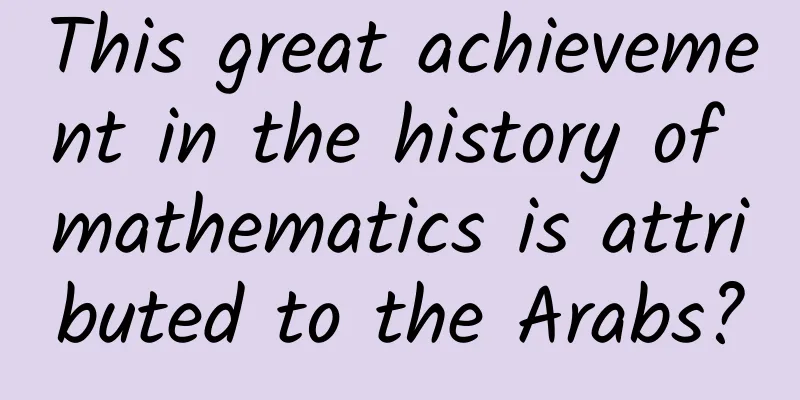This great achievement in the history of mathematics is attributed to the Arabs?

|
This article briefly introduces the early development of algebra, including the origin of the word "algebra", the algebra content in "Nine Chapters on the Mathematical Art", the 9th century Arab mathematician Al-Khwarizmi and the main content and influence of his "Algebra". Through rich historical materials, we can have a more comprehensive understanding of the early history of algebra. Written by Guo Yuanyuan (Institute of the History of Natural Sciences, Chinese Academy of Sciences) Algebra is one of the most important basic branches of mathematics. Algebra can be divided into elementary algebra and abstract algebra according to the order of development. Elementary algebra refers to the theory of equations before the first half of the 19th century. It mainly studies whether a certain equation (group) is solvable, how to find all the roots of the equation (including approximate roots) and the various properties of the roots of the equation. At the end of the 19th century, algebra shifted from the theory of equations to the study of algebraic operations, which opened the prelude to abstract algebra. How did algebra originate? There was arithmetic before algebra. The main difference between algebra and arithmetic is that algebra introduces unknown variables, lists equations according to the conditions of the problem, and then solves the equations to find the unknown values. Although some sporadic algebra content can be found in early civilizations such as ancient Egypt, Babylon, ancient Greece and ancient China, algebra and arithmetic have been together for a long time. The development of algebra into an independent branch of mathematics should be attributed to the Arabs in the Middle Ages. The earliest algebraic work was "The Book of Reductions and Cancellations" (abbreviated as "Algebra", about 820) by the Arab mathematician Muhammad ibn Mūsā al-Khowārizmī (about 780-about 850) in the early 9th century, which marked the birth of elementary algebra. 01 The Origin of the Word "Algebra" In fact, the word "algebra" in Chinese today does not come from classical Chinese mathematics, but from the title of Al-Khwarizmi's book "Kitāb al-jabr wa-al-muqābala", in which "al-jabr" means "reduction". Al-Khwarizmi defined it as an operation that transfers a subtracted quantity on one side of an equation to the other side of the equation and turns it into an added quantity, for example, 5x+1=2-3x becomes 8x+1=2, which is a "reduction" process. The "al-muqābala" in the title means to eliminate the same positive terms on both sides of the equation, for example, 8x+1=2 becomes 8x=1, which is a "cancellation" process. Later Arab mathematicians gradually used the word "reduction" to replace "reduction and cancellation", which gradually evolved into today's transfer of terms and merging of like terms in equation simplification. Later, Arab algebra was introduced to Europe, and the word "reduction (al-jabr)" evolved into the English word "algebra". At the end of the 16th century, Jesuit missionaries from Europe came to China, marking the beginning of the spread of Western learning to the East in the late Ming and early Qing dynasties. Around the 51st year of Emperor Kangxi’s reign (1712), Jesuit Jean-Françoise Foucquet (1665-1741) first introduced symbolic algebra to China and wrote “The New Method of Aljebara” for Emperor Kangxi, in which “Aljebara” is the transliteration of algebra. In addition, the word has other translations such as “Aljubar”, “Aljebada” and “Aljebara”. Regarding the above Chinese translations, the late Qing Dynasty’s “Records of Chinese and Western News” records: There is a book on mathematics in the Arab country called Ala Rebalai Ala Mogabala. The meaning of the name is the method of complementation and the method of mutual elimination. [Ala means "it", Rebalai means "ability", and the algorithm for converting fractions into integers. Mogabala means relative, compared, equal, that is, mutual exchange.] Over the years, it has been called Ala Rebala for its meaning of complementation and mutual elimination. After Emperor Kangxi, Aljebala was misinterpreted as "the method from the East" and widely circulated, which was the basis for the theory of "Western learning originated from the East". At the same time, Emperor Kangxi accepted the proposal of Chen Houyao (1648-1722), a Jinshi from Taizhou, to "prepare various books on step-by-step mathematics to benefit the world". In the 51st year of Emperor Kangxi's reign (1712), he issued an imperial decree to open Mengyangzhai (Mengyangzhai was called the Chinese Royal Academy of Sciences in the West), and granted the title of Juren to Mei Yucheng (1681-1763), the grandson of Mei Wending (1633-1721), and appointed him as the compiler of Mengyangzhai. Together with Yunzhi and Yunlu, they began to compile "Mathematical Essence", which was completed in the 61st year of Emperor Kangxi's reign (1722). The book collected Western mathematical knowledge introduced into China in the late Ming Dynasty and absorbed some research results of Chinese mathematicians at that time. Volumes 31-36 of the second volume of "Mathematical Essence" have "borrowing root square proportion", which introduces the addition, subtraction, multiplication and division rules of polynomials, and introduces the concepts of plus sign, minus sign, equal sign, and transposition, so as to use algebraic methods to find solutions to higher-order equations. Volume 31 says, "borrowing root square is a method of borrowing root numbers and square numbers to find real numbers." "Root number" is the unknown number, and "square number" is the positive exponential power of the root number. Mei Jucheng believes that the Western name of "borrowing root square" "Arjebada" is "Eastern Method", which is the product of the "Li Tianyuanyi" method in the Song and Yuan dynasties that was spread to the Western Regions and then spread back again. In this way, the Western algebra "borrowing root square" introduced during the Ming and Qing dynasties stimulated the Qianlong and Jiaqing scholars to explore the mathematical classics of the Song and Yuan dynasties, and then provided the possibility for Western scholars such as Alexander Wylie (1815-1887) to compare, communicate and learn from each other between Chinese and Western mathematical cultures. Since the 1720s, missionaries were prohibited from preaching in the interior until the opening of ports after the Opium War. The introduction of Western mathematics was basically interrupted and continued until around 1850. In 1847, the British Alexander Wylie came to Shanghai to learn Chinese. In 1853, he wrote "Mathematical Enlightenment" in Chinese to introduce Western mathematics. ** In the preface of "Mathematical Enlightenment", Alexander Wylie said: "There are books on algebra and differential calculus..." This is the first time that the Chinese word "algebra" was used as the name of a branch of mathematics. ** In 1859, Li Shanlan (1811-1882) and Alexander Wylie translated "Algebra and Calculus" and "Algebra" and published them. The original text of "Algebra and Calculus" was "Analytical Geometry and Calculus" written by American mathematician E. Loomis (1881-1889) in 1851. The original version of "Algebra" is "Elements of Algebra" written by the British Augustus De Mogan (1806-1871; the name is taken from ancient books, and is now generally translated as De Morgan) in 1835. When it was translated into Chinese, it was named "Algebra". This is the first book in my country named "Algebra". The book points out that the word "algebra" means "using characters to replace numbers", that is, using the elements of Jia, Yi, Bing, Ding to replace known numbers, and using the elements of heaven, earth, and people to replace unknown numbers. The algebraic terms in the translation originated from the traditional Chinese algebra Tianyuanshu, but it denied that "borrowing roots" was an "Eastern method". More than a decade after the publication of "Algebra", the spread of symbolic algebra in China was not smooth. It was not until 1872 that the translation of "Algebra" by Hua Hengfang (1833-1902) and John Fryer (1839-1928) was published, and Western symbolic algebra became popular and spread. 02 Algebra before Al-Khwarizmi Compared with arithmetic operations between numbers, the subtlety of elementary algebra lies in the fact that the process of dealing with problems involving unknown numbers is usually mechanized: first, the unknown number to be sought is set as "something" or "some quantity" (generally set as x today), and an equation is established; then, in the process of simplifying the equation to a standard form, this "something" or "some quantity" can participate in operations like known numbers, such as "transferring terms", "merging" or "cancelling", etc. It can replace the complex conditional analysis process that the human brain originally needs to perform. This is like using an abacus for arithmetic operations. People use the shape, formulas and mechanical beads of the abacus to replace a lot of mental labor, so that they can calculate accurately for a long time. Some readers may be curious. As early as 2,300 years ago, the ancient Greek mathematician Euclid (about 330-275 BC) was able to solve complex graphic problems in his "Elements of Geometry" and laid the foundation for today's geometry. Why can the above-mentioned seemingly "simple" algebraic ideas only be traced back to the early 9th century AD? In fact, the above-mentioned elementary algebra content can be found in the earlier mathematical civilizations of ancient Greece, ancient India and ancient China. The following is an example of the equation chapter of "Nine Chapters on the Mathematical Art" in classical Chinese mathematics. The equation method given in the eighth chapter of the Nine Chapters on the Mathematical Art, which was written in the Han Dynasty, is equivalent to the current method of solving linear equations. It is one of the most outstanding mathematical achievements of the Nine Chapters on the Mathematical Art. The first question of this chapter proposes the equation method, which is the outline of the whole chapter. All 18 problems in this chapter must be solved by the equation method. The second question proposes the loss and gain method, which is a method of writing equations. The third question proposes the positive and negative method, which is a method of dealing with negative numbers in the process of elimination or in the equation itself, and is a necessary supplement to the equation method. If x, y, and z represent the actual number of dou in the first question of the Nine Chapters on the Mathematical Art, we get the linear equation system: Then use direct division to eliminate the variables. The so-called direct division method is to subtract the whole row from the whole row. The establishment of the equation and the elimination transformation here adopt the positional value system. Each number does not need to be marked with what item it is the coefficient of, but is represented by its position, which is consistent with the separation coefficient method in modern mathematics. The representation of the equation in "Nine Chapters on the Mathematical Art" is equivalent to listing its augmented matrix, and the elimination process is equivalent to matrix transformation. For example, the elimination process in question 1 is equivalent to the augmented matrix transformation: The method of loss and gain is an important method used in establishing equations in the Nine Chapters on the Mathematical Art. The second question in the chapter on equations states: loss is called gain, and gain is called loss. "Loss is called gain" means that if one end of a relationship loses a certain amount, it is equivalent to gaining the same amount on the other end; similarly, "gain is called loss" means that if one end of a relationship gains a certain amount, it is equivalent to losing the same amount on the other end. The method of loss and gain is equivalent to moving a term from one end of an equation to the other end, and changing the sign after moving the term. For example, the original question of the second question is: Now there are seven bunches of upper wheat, and the fruit is reduced by one dou, and two bunches of lower wheat are added, and the fruit is eleven dou. If the fruit of one bunch of upper and lower wheat is x and y respectively, it is equivalent to giving the relationship: (7x-1)+2y=10. Through the method of loss and gain, the equation can be transformed into: 7x+2y=11. The chapter on equations in the Nine Chapters on the Mathematical Art also introduced negative numbers and proposed the addition and subtraction rules of positive and negative numbers, which is no different from today's methods. The introduction of negative numbers is another important expansion of the number system and an important achievement of ancient China. The "Loss and Gains" in the Equation Chapter of "Nine Chapters on the Mathematical Art" While marveling at the achievements of ancient Chinese mathematicians, we should also realize that the cross-civilization dissemination and evolution of ancient mathematical knowledge is usually not a "Whig history" process from one "milestone" to another, but a very complex and diversified process. So far, there is no evidence that the above-mentioned ancient Chinese algebraic ideas influenced Al-Khwarizmi. Similarly, Al-Khwarizmi's Algebra also does not contain any traces of algebra in ancient Greek mathematical works such as Euclid's Elements and Diophantus' (ca. 246-330) Arithmetic. Although Al-Khwarizmi's Algebra reflects the characteristics of Indian mathematics in individual problems, it is more original in terms of language expression, chapter arrangement, and presentation of ideas. There are many examples of this nonlinear characteristic of ancient mathematical knowledge in the process of cross-civilization transmission and evolution. For example, in the early 15th century, the Persian mathematician al-Kāsh (ca. 1380-1429) used the numerical solution of cubic equations to obtain arbitrary precision values of sin1° to improve the accuracy of sine tables, but this algorithm was not introduced to Europe. In the mid-16th century, the Austrian mathematician Rheticus (1514-1574) began to work on solving high-precision sine tables. It was not until half a century later that the German mathematician Pitiscus (1561-1613) achieved the achievement of al-Kāsh nearly 200 years ago in his book Trigonometry published in 1595. In 1631, when the German missionary Jean Terrenz (1576-1630) compiled "Da Ce" based on "Trigonometry" and introduced it to China, he did not include the above algorithm in "Da Ce"; it was not until 1722 in "Summary of Mathematics" that Chinese mathematicians independently explored and mastered the above algorithm, but at this time it had been 300 years since Cassie solved the problem. 03 Al-Khwarizmi's Life and the Main Contents of Algebra There is little information about Al-Khwarizmi's life, which is not an exception among famous ancient mathematicians. For example, there is little information about the life of ancient Greek mathematician Euclid, ancient Chinese mathematician Liu Hui (3rd century AD), Jia Xian (11th century), etc. Al-Khwarizmi's full name is Muhammad ibn Mūsā al-Khowārizmī. According to the characteristics of Arab names, his name should be Muhammad. Among them, "Ben" means son, so "Ben Musa" indicates that his father is Musa. The last word indicates that he came from the Khwarazm region in Central Asia, but we know nothing about when his fathers or earlier ancestors came to Baghdad. We only know that he lived in Baghdad and did not go anywhere else. Al-Khwarizmi has a total of 12 works, which cover a wide range of topics, including mathematics, astronomy, chronology, topography and history. In addition to "Algebra", his mathematical works also include a book called "Book of Indian Arithmetic", which systematically introduced the Indian decimal system and related calculation methods for the first time in the Arab world. It is definitely not accidental that a great scientist like Al-Khwarizmi emerged in the Arab region in the early 9th century. It is the result of the combined effects of political, economic, cultural and other factors. It is inferred that Al-Khwarizmi was born in the last decade of the 8th century AD and received education in Baghdad, where the academic atmosphere was prevalent at that time. The seventh caliph of the Abbasid Dynasty, al-Ma'mūn (813-833), built the "Palace of Wisdom" in Baghdad and launched the "Hundred Years of Translation Movement". Al-Khwarizmi was invited to work in the "Palace of Wisdom" during this period, completed "Algebra" and expressed his respect and gratitude to Ma'mūn in the preface of the book. Al-Khwarizmi was still alive in 847 AD when the ninth caliph al-Wāthiq (reigned 842-847) died. A commemorative stamp of Al-Khwarizmi issued in 1983 The main body of Al-Khwarizmi's Algebra is divided into four parts: the theory of quadratic equations, trade problems (the law of three rates), geometric measurement problems, and inheritance problems. The book begins by introducing six types of standard equations composed of roots (i.e., linear terms), squares (i.e., quadratic terms), and numbers (i.e., constant terms): 1. Square equals root (ax^2=bx); 2. The square is equal to the number (ax^2=c); 3. The root is equal to the number (bx=c); 4. The sum of the square and the root is equal to the number (ax^2+bx=c); 5. The sum of the square and the number is equal to the root (ax^2+c=bx); 6. The sum of the root and the number is equal to the square (ax^2=bx+c, where a, b, c>0). When constructing equations, Al-Khwarizmi only considered equations with positive roots. The simplified standard form equation must be that the sum of some positive terms is equal to the sum of other positive terms. Under the premise of ensuring that the equation has positive roots, the above six equations are equivalent to the standard form of quadratic equations ax^2+bx+c=0(a, b, c∈R). The solutions to the first three types of equations are relatively simple. For the last three types of equations, Al-Khwarizmi first reduced the coefficients of the quadratic terms to 1, and then elaborated on the root-finding formula in words. For example, the fifth equation is equivalent to: Al-Khwarizmi's Algebra (1342 edition) The six equations listed above are in standard form, but the equations listed according to the question are usually in different forms, so Al-Khwarizmi then gives a method to simplify the equations, that is, simple rules of integer operations. The second and third parts of the book - business problems and geometric measurement problems are very short, and the last half of the book is used to explain 58 inheritance problems related to Islamic inheritance law, which are essentially complex linear equations of one variable. Let's take the first question as an example, which is also the simplest one: If a man dies and leaves two sons, and bequeaths one third of his total estate to a stranger, and he leaves a legacy of ten dirhams, and one of his sons is in debt to his father, he shall not have any share of the ten dirhams. A son owes his father a debt. Let the son's debt be x. Add it to the property left by his father and distribute it. The total estate is 10+x. The estate received by the son offsets his original debt, and we have: The stranger received 5 dirhams, one of the sons received 5 dirhams, and the other son who was in debt received an inheritance that offset the original debt. The act of algebraically solving the complex inheritance distribution problem stipulated in Islamic inheritance law reflects the good companionship between mathematics and religion at that time. In fact, this companionship runs through the golden age of Islamic mathematics development in the Middle Ages. Similarly, the "Qibla" problem caused by believers finding the precise direction of Mecca to pray promoted the rapid development of Arabic trigonometry. Important problems in religion provide impetus for the development of mathematics, and at the same time give mathematics a higher prestige and status, which all reflect the diversified cultural characteristics of mathematics in the process of development. 04 The Far-reaching Influence of Al-Khwarizmi's Algebra For readers who read Al-Khwarizmi's Algebra for the first time, it does not seem to give people a bright feeling. This is not a huge work, but a slightly thin booklet; there are no complex problems in the book, and today's junior high school students have no difficulty reading it; there are no algebraic symbols in the book, and everything is expressed in text, giving people a "primitive" feeling. However, due to the clear explanation of the equation idea, practical value and official background, the book quickly attracted great attention. Many mathematicians of the same period as Al-Khwarizmi and slightly later participated in the in-depth discussion of Algebra. For example, ibn Turk (9th century) of the same period supplemented Al-Khwarizmi's geometric proof of the correctness of the formula for finding the roots of quadratic equations; Thabit ibn Qurra (826-901), who came a little later, was the first to conduct an in-depth comparative study between Euclid's Elements and Al-Khwarizmi's Algebra; Abū Kāmil (c. 850-c. 930) fully inherited and developed Al-Khwarizmi's algebraic ideas. On the one hand, the work of Ibn Tuq, Tabi ibn Qura, Kamil and others further clarified Al-Khwarizmi's algebraic ideas and provided later Arab mathematicians with a broader research perspective and richer research content in the field of simplification and solving equations; on the other hand, it was precisely because of their participation in the research of Al-Khwarizmi's "Algebra" that the names of the above-mentioned mathematicians were engraved in the "merit book" of the history of mathematics. The "reduction and cancellation" method in Al-Khwarizmi's book "Algebra" has been preserved for a long time as a basic feature of algebra. At the same time, the book basically determined the two main development threads of equation simplification and equation solving in later Arabic algebra. The first person to make a breakthrough in the field of equation simplification was al-Karaji (953-about 1029). His work made algebra further "independent", which was equivalent to systematically applying the basic arithmetic methods of addition, subtraction, multiplication, division, proportion and square root to algebraic expressions. Later, al-Samaw'al (about 1130-about 1180) further developed Karaji's theory. In the end, this basic operation steps and simple arithmetic methods derived from the process of equation simplification developed into a relatively complete theory through the efforts of Arab mathematicians. Mathematicians such as Al-Khwarizmi, Tabi ibn Qurra, and Kamil have achieved relatively complete results in algebraic solutions, geometric solutions, and numerical solutions of quadratic equations. The first person to make a breakthrough in the field of solving general higher-order equations was Omar Khayyam (1048-1131). Khayyam's greatest contribution was that he gave a geometric solution to a cubic equation based on Greek mathematical knowledge, which essentially used the intersection of conic sections to qualitatively describe the solution of the equation. The first person to make a breakthrough in the field of numerical solutions of general cubic equations was Sharaf al-Dīn al-Tūsī (ca. 1135-1213), which laid the foundation for later mathematicians to perform high-precision numerical solutions. Illustration of Khayyam's solution to x^3+c=bx (the intersection of the parabola and the hyperbola represents the root of the equation) Al-Khwarizmi's "Algebra" was translated into Latin in the 12th century and began to spread in Europe. The Latin translation of Al-Khwarizmi gradually evolved into the two English words "algorithm" and "algorithm". The former word means "Arabic numeration"; the latter word became the proper noun "algorithm" in mathematics, which means the specific calculation steps to solve a certain problem. In the early 13th century, Italian mathematician Fibonacci (c. 1175-c. 1250) described the algebraic content in Camille's book in his masterpiece "The Book of Calculation". In the marginal note on page 406, Maumeht (i.e. Muhammad) was mentioned to make it clear that the solution to the quadratic equation came from Al-Khwarizmi. Since the 13th century, the origin of European scientific struggle has been to digest, absorb and surpass the works of scholars such as Fibonacci. Subsequently, many European mathematicians were also attracted by Arabic algebra and have been committed to finding algebraic solutions to general cubic equations. In 1545, Italian mathematician Cardano Girolamo (1501-1576) published a Latin book on algebra "The Great Art" in Nuremberg, Germany. The root-finding formulas for general cubic and quartic equations were finally made public, which also marked that Europeans truly took over the mathematical baton passed on by the Arabs. After unremitting efforts, European mathematicians finally proved in the early 19th century that the general quintic equation has no algebraic solution, which opened up the study of modern algebra. In the early 19th century, medieval Arabic mathematics attracted the attention of European mathematical historians, and Al-Khwarizmi's Algebra was translated into English, French, Russian, etc. The Chinese translation of Al-Khwarizmi's Algebra published by the author in 2020 References [1] Al-Khwārizmī, Edited with translation and commentary by Roshdi Rashed, The Beginnings of Algebra[M], SAQI, Landon, 2009. [2]Martin Levey, the algebra of abu Kamil, kitab fi al-jabr wa'l-muqabala[M], in a commentary by Mordecai Finzi, Hebrew text, translation, and commentary with special reference to the Arabic text, the university of Wisconsin press: Madison, Milwaukee, and London, 1966. [3] S.Ahmd and R.Rashed eds., al-Samaw'al, al-Bahir en algebra[M], Damascus, 1972. [4] R.Rashed et. B.Vahabzaded. Al-Khayyam Mathematicien[M]. Paris: Librairie Scientifique et Technique Albert Blanchard, 1999. [5]R.Rahed, Sharaf al-Din al-Tushi, CEuvres Mathematiques[M], Algebra et Geometrie au XII siècle. Collection Science et Philosophie Arabes. Paris: Societe d'edition, 1986.(Tome I, II.) [6] Jamshid al-Kāshī. Miftah al-Hisab (Key to Arithmetic)[M]. AS al-Demerdash.MH al-Cheikh (eds). Cairo: Dār al-kātib al-ʿarabī,1967. [7] Bartholomæi Pitisci Grunbergensis Silesij Trigonometriæ Siue De dimensione Triangulor[um] Libri Qvinqve; Item Problematvm Variorv[M], nempe Geodæticorum, Altimetricorum, Geographicorum, Gnomonicorum et Astronomicorum Libri Decem. Augsburg, 1612. [8] Chen Zhihui. The revival, exchange and mutual learning of Song and Yuan mathematical research[J]. Chinese Social Sciences Today. 2024.1.24.A05. Special Tips 1. Go to the "Featured Column" at the bottom of the menu of the "Fanpu" WeChat public account to read a series of popular science articles on different topics. 2. Fanpu provides a function to search articles by month. Follow the official account and reply with the four-digit year + month, such as "1903", to get the article index for March 2019, and so on. Copyright statement: Personal forwarding is welcome. Any form of media or organization is not allowed to reprint or excerpt without authorization. For reprint authorization, please contact the backstage of the "Fanpu" WeChat public account. |
<<: Why do people still get shorter as they age? "Height reduction" may be related to these reasons
>>: People who blush when excited must be careful of this disease
Recommend
Uncover the magic behind the browser: the entire process from URL input to page display
In the digital age, browsers have become our gate...
Flink Principles and Implementation: Architecture and Topology Overview
To understand a system, we usually start with the...
If you have heel pain, don’t just bear with it!
Author: Tang Qin, Deputy Secretary-General of the...
Can corn silk water lower blood pressure and blood sugar? Be careful if you eat it wrong, or the blood pressure will get even higher!
"Corn silk water can 'diuretic and blood...
The blender is too cruel! The Apple Watch instantly turned into dregs
A few days ago, we gave the Apple Watch a scratch...
Using the growth model to review Himalaya FM’s product growth
I am a product dog. Curiosity drives me to consta...
Why are there such big differences in the prices for WeChat mini program development and mini program development?
It has been 6 years since the mini program was la...
GMGC2016 Shengji Network will be the diamond sponsor to support the 5th Global Mobile Game Conference
The fifth Global Mobile Game Conference GMGC2016, ...
Apple reminds developers to implement new IDFA policy after iOS 14.5 is officially launched
[[391378]] On the morning of April 6, Apple remin...
WeChat suddenly announced that after May 20, the mini program will shut down a much-criticized service
According to CNMO Mobile China, the WeChat Open C...
Sony to slash staff: Will halve smartphone business staff by March next year
Another tech giant is laying off employees! Accor...
Archaeologists use high technology to restore the Great Wall with remote sensing and make ancient people "speak" with DNA technology
Produced by: Science Popularization China Author:...
If you find an illegal mini program, how do you report it?
Q: How do I report a mini program? Or can someone...
CES2015: ZTE releases 6-inch ultra-large screen mobile phone Grand X Max+
On January 6, 2015, Beijing time, ZTE Mobile Comm...
Water celery or poison hemlock? Don't pick wild vegetables on the roadside
As spring arrives and the temperature rises, many...









